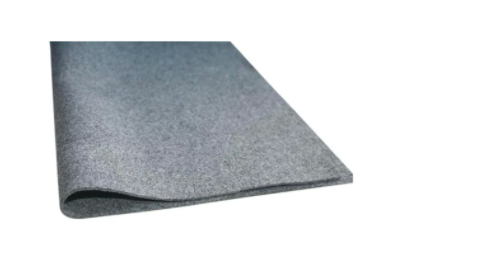- Understanding the Role of Geomembrane Liners in Waste Management
- Innovations in Geomembrane Liners for Water Management
- Geomembrane Liners: A Comprehensive Guide
- The Future of Geomembrane Liners in Civil Engineering
- Geomembrane Liners: Enhancing Landfill Stability
Manager:
WhatsApp:+86 177 0135 2670
Tel:+86 177 0135 2670
Email:marketing@okorder.com
Address:3rd Floor, No.2 Building, No.1 Sanlihe Road
The Intangible Power: Discovering Non-Woven Geotextile Fabric World
Amongst the intricate ballet of modern engineering and ecological preservation, non-woven geotextile fabric emerges as a mute accomplice having strength, stability and answers to countless geotechnical issues. They are fabrics made from the combination of innovation and functionality used in many purposes such as strengthening soil structure to control water flow. This article takes you on a journey through the world of non-woven geotextile fabric, exploring its history, applications, and the profound impact it has on the landscape of construction and environmental conservation.
Non-woven Geotextiles Essence
Non-woven geotextile is a strong synthetic material that is made from polyester or polypropylene fibers which are bonded together by needle punching or heat treatment. In this way it is made flexible and yet durable enough to be able to withstand various activities involved in construction without breaking apart. The non-woven geotextile is not just any material but symbolizes our commitment towards building a stronger sustainable future.

A Mix of Durability And Design
Non-woven geo textile manufacturing process shows how human beings have been creative. A random orientation of layers of fibers followed by bonding ensures that fabric remains strong and stable (Liu et al., 2010). Fiber layers may also be customized during production for specific projects thereby making them ideal for engineers as well as designers alike. Ultimately this results in functional materials that can fit into various needs of modern day buildings.
Construction and Landscaping Applications
Non-woven geotextiles are central when it comes to constructions including landscaping projects. It can serve such roles as reinforcing soil against erosion; improving water flow/drainage amongst others (Koerner, 2013). When developing drainage systems for instance French drains using this type of fabric helps because it will allow water to pass through while retaining soil particles hence promoting aeration and filtration of water. On the other hand, in landscaping, non-woven geotextiles help in preventing soil erosion while providing a stable base for plants as well as improving the overall health of landscapes.
Reinforcement and Stabilization
The most notable utilization of nonwoven geotextile fabric is on reinforcement and stabilization. It is preferred because it raises shear strength of soils such that they do not deform under load, thus making it useful in building roads, landfills among others where strong & durable foundations are needed (Rowe et al., 2007). The strength of such materials allows them to be applied even on various surfaces thereby giving them options to adapt on heavy usage or different landscapes.
Concentration on Environmental Conservation and Protection
Non-woven geotextiles play an important role in environmental conservation. They are used as liners for landfills and other waste containment structures so as to prevent migration of contaminants. These fabrics also promote slope protection measures through their use in erosion control which prevents natural or man-made hazards from damaging landscapes. The reason why this is done with our environmental projects reflects the collective efforts we all put towards protecting nature and conserving resources.
The Economical Choice: Cost-Effectiveness and Sustainability
Non-woven geotextile fabric stands out among them as being the most cost-effective. It is comparatively affordable compared to other materials for many geotechnical applications. Moreover, the use of fake materials in making this stuff makes it sustainable for construction activities since these materials are solid and can be recycled thus reducing pollution from the construction process. A combination of budget-friendly features and sustainability factors make non-woven geotextile fabric a preferable option for both big and small projects.
Installation and Maintenance: A Seamless Experience
It is easy to install non-woven geotextile fabric which sets it apart. This implies that its flexibility allows it to take up irregular surfaces as well as difficult structures. Low demands on care due to the material’s longevity guarantee low operational costs in future periods of use. Thus, such simplicity of installation together with maintenance causes non-woven geotextile fabric perfect option in multiple cases.
The Future of Non-Woven Geotextile Fabric: A Promising Outlook
The place of non-woven geotextile fabrics in engineering and environmental conservation has been predicted to rise with changes in the building industry. Continuing research will show further improvements on properties relating to this particular material as well as more uses for it, which ultimately enhance its performance and flexibility. Henceforth, there seem to be promising prospects for improving some aspects related to manufacturing plus application techniques typical of n.w.g.f., thereby making them even more influential within civil geo-technical sector.
Conclusion: A Fabric Interwoven with Progress and Protection
In conclusion, non-woven geotextile an essential component in modern infrastructure development as far as engineering works and preservation of environment are concerned worldwide. Its uniqueness lies within its various uses alongside promoting sustainable practices thus being a must-have element in constructing contemporary installations’ infrastructure. As we continue seeking ways out or developing something new, the role of non-woven geotextile fabric will remain important in our journey towards a better tomorrow where humans live on a stable planet by the way of preserving it for future generations.
The non-woven geotextile fabric is more than just a material; it is a symbol of our commitment to progress and protection. In this respect, let us adopt its usage as we transit into the future because these unassuming elements are behind our dreams with silent strength and resilience. The non-woven geotextile fabric is an assertion of our ability to make things, innovate and have a better world one step at a time.
- Previous:Geotextile Fabrics: The Unrecognized Champions of Modern Infrastructure
- Next:Weaving Strength and Sustainability: Woven Geotextiles in Modern Construction
-
2024-07-26The Essence of Non-Woven Geotextiles






